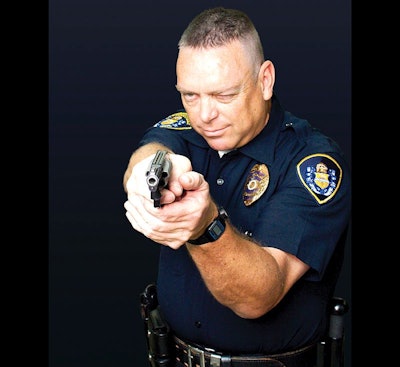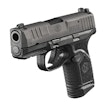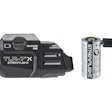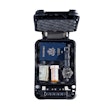 According to our survey, many law enforcement agencies nationwide are allowing their officers to carry more than one handgun on duty, as well as off duty.Photo: Dave Douglas
According to our survey, many law enforcement agencies nationwide are allowing their officers to carry more than one handgun on duty, as well as off duty.Photo: Dave Douglas
Few pieces of police gear are more controversial than backup guns and off-duty guns. Some members of the public are not comfortable with law enforcement officers having a service pistol, much less a backup to their service pistol. And the same people aren't happy that law enforcement officers carry concealed off duty.
Politics aside, however, it appears that many law enforcement agencies nationwide are allowing their officers to carry more than one handgun on duty and carry a personal protection pistol off duty. The reasoning for this is easily understood. Most agencies no longer run two-officer patrol cars, so their officers are out on their own and need a second handgun. And officers who carry off duty are not only protecting themselves and their loved ones, they are a force multiplier for agencies and the communities they serve. Officers who carry during their off-duty hours often stop crimes before they escalate into tragedies, and they can provide valuable backup to on-duty officers when needed.
POLICE Magazine wanted to know more about backup handgun and off-duty handgun carry, so we sent out a survey covering these issues and the issues retired officers face when carrying under the Law Enforcement Officers Safety Act. The survey, which was open to active, former, and retired officers, was sent to 33,000 readers of POLICE and 1,881 qualified readers responded for an error level of less than 2%.
Backup Guns
The first question in our survey naturally covered whether the officer's agency permitted its sworn personnel to carry more than one handgun on their person while on duty. There seems to be good news on this front, as 85% of respondents said their agency permitted backup handguns.
Our next question may have seemed a little odd to some readers. We asked how many backup handguns they carry. One was by far the most popular answer at 94%. Which would seem obvious, but we have heard of officers carrying a backup and a smaller third gun. So it didn't surprise us that 6% of the readers said they carry three or more handguns—counting their duty pistols—on duty.
We were also curious about the caliber of handgun most commonly carried by officers as a backup. As in the civilian personal defense market, the 9mm was the most popular cartridge at 32%. Other popular responses included .38 Special at 20%, .40 S&W at 17%, and .380 ACP at 16%. For larger rounds, .45 ACP was popular with 5% of respondents and a few said they carry .44 Special. Such small rounds as .25 ACP and .32 ACP were not very popular but some officers indicated their backup gun is a .22. Expanding on this topic we asked if the officers' backup handgun was the same caliber as their service pistols and 57% said no. Another follow-up question was about dual use magazines. Only 27% of respondents said their backup guns can use the same magazines as their service pistols.
Some agencies are known to issue backup guns to their officers, but this practice is not widespread. A little more than 94% of respondents said they had to buy their own backup guns. We also asked readers how much they paid for their backup guns. The sweet spot on price is $300 to $499, accounting for 70% of backup gun purchases by the respondents.
One of the bigger concerns about backup guns in the past was that many agencies did not have specific policies that covered them. This appears to be changing. More than 91% of respondents said their agencies have a policy requiring them to qualify with their backups.
How officers carry backup guns was a point of interest for us. More than 42% said they carry their backups in ankle holsters and 16% said they carry their backups at the waist. Some 41% said they carry their backups in other locations. Answers for other locations included body armor pouches or holsters, shoulder holsters, and in pockets.
Our final questions involving backup guns covered their actual use on duty. We asked the readers if they have ever had to draw their backup guns on duty. More than 92% of the respondents said they have not.
Of the more than 7% of respondents who have had to draw their backup guns on duty, we asked for their stories. Here's some of what they told us: gun grabs were a common scenario, as were ground fighting situations where officers found themselves lying on their primary weapons, situations where officers were in cars and needed a firearm in hand and they found their backups to be more accessible, and malfunctions of their primary handguns during critical situations. Another common response was providing a handgun to a fellow officer who left their duty weapon behind at the jail.
In most of the incidents detailed by respondents, the backup gun was not fired. However, 10 respondents said they have had to open fire with their backup handgun while on duty and not in training. Some of these involved euthanizing injured animals. But some involved harrowing attacks, including situations where officers ran out of ammo for their duty weapons during gunfights. One officer wrote that he used his backup to end a potentially deadly gun grab attack: "I was fighting with a gang member after a foot pursuit. I fought with him for about four minutes. He was trying to take my duty weapon. I reached down and drew my Walther PPK and made one contact shot to the middle of his chest, ending the assault."
Off-Duty Guns
The second portion of our survey was about off-duty carry.
More than 96% of respondents said they carry off duty. Of those who do not carry off duty, some respondents said they didn't want to, some said their agencies prohibit off-duty carry, some said it's uncomfortable and a hassle, and some said they could not carry because they frequent locations that ban handguns and will not allow off-duty officers to be armed.
As with backup guns, 9mm is the most popular caliber for off-duty handguns. More than 45% of respondents said they carry 9mm handguns when off the job. Other popular off-duty calibers include .40 S&W at 21%, and .45 ACP at 11%. Respondents also carry some unusual calibers of handguns in their off-duty hours, including 10mm, .22, and FN's 5.7x28mm.
Only 16% of respondents said their duty handgun is also used as their off-duty handgun. But 57% said they carry the same caliber of handgun off duty as their duty weapon.
As we did with backup guns, we asked respondents how they carry their off-duty handguns. More than 76% said their preferred carry position is at the waist, 7% said they carry on the ankle, and 17% said other locations, including pockets, purses, belly bands, shoulder packs, and fanny packs. Some respondents also mentioned that the positioning of their off-duty guns is dependent on their clothing choices and planned activities.
Another question covered what law enforcement gear the respondents carry off duty in addition to a handgun. Popular answers included: knives, flashlights, Kubatons, expandable batons, handcuffs/flex cuffs, spare magazines, OC spray, tourniquets, and ID/badges.
As with backup guns, we were interested in whether officers have had to draw their off-duty handguns other than in training. Some 25% said they have done just that. Out of those respondents, most said they have never had to fire their off-duty weapons outside of training. However, 50 respondents indicated they have had to open fire off duty someplace other than the range. Some of these incidents may have involved animals such as one respondent who said he once fired his off-duty weapon to ward off a charging moose. But some of these incidents were gunfights.
For both backup guns and off-duty guns, we asked our readers about brand preference. It's no surprise given the company's prevalence in the law enforcement market that Glock is the most popular brand for both missions. The next most popular backup and off-duty gunmaker among respondents was Smith & Wesson, followed by SIG Sauer. Other brands that were popular included: Ruger, Colt, Walther, Kel-Tec, FN, and Springfield Armory.
LEOSA Carry
There are few aspects of law enforcement carry off the job that are more complicated than LEOSA. The federal law seemed straightforward when it was first enacted in 2004. It allowed active and retired sworn law enforcement officers to carry across jurisdictions, regardless of local law. But it hasn't worked out to be so simple. Who qualifies, how they qualify, what credentials they have to carry, and resistance from local jurisdictions to recognize federal law make LEOSA a subject that could fill a book.
We wanted to know if POLICE readers are benefitting from LEOSA, so we asked a series of questions on the topic. More than 68% of respondents said they have used LEOSA rights to carry off duty outside of their jurisdictions.
A full 61% of retired officers responding said they carry concealed using LEOSA credentials. Of the retired respondents who do not have LEOSA credentials, the most common reason involved their former agencies. Slightly less than 20% said their agencies will not certify retired officers. Other reasons retired officers say they do not have LEOSA credentials include: living in a state that does not recognize LEOSA, too many hoops to jump through, not knowing how to apply, strict local gun laws, and they don't want the LEOSA credentials because they have a state concealed carry permit and do not plan to travel.













